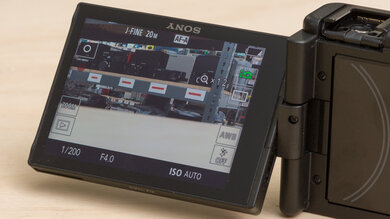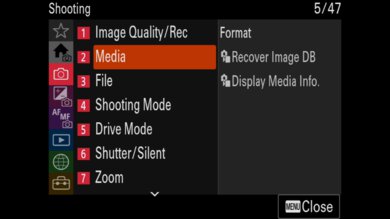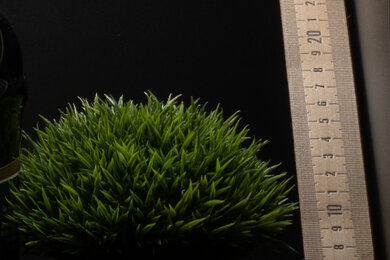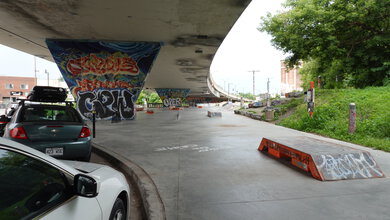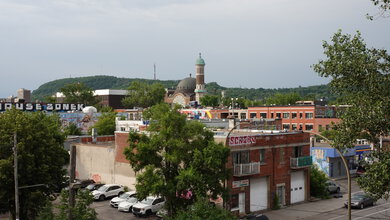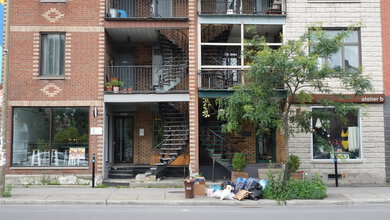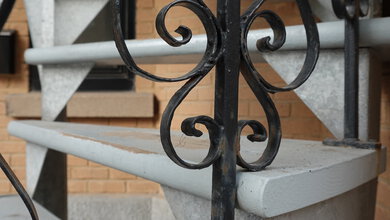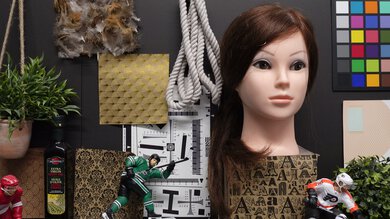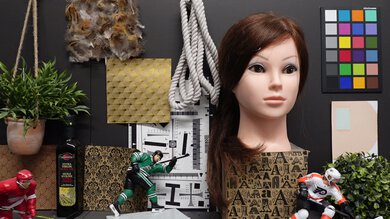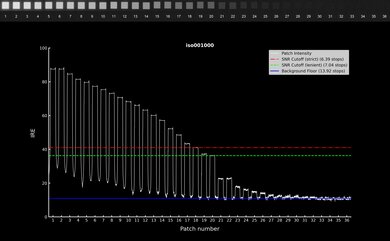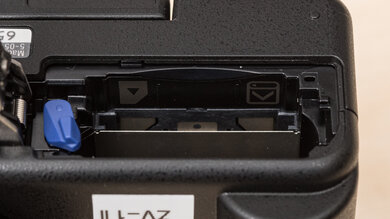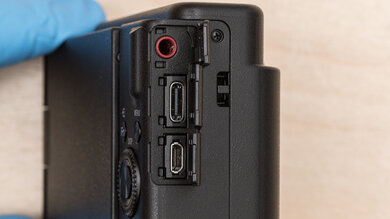The Sony ZV-1 II is a compact vlogging camera. The follow-up to the Sony ZV-1 features a new lens with a wider 18-50mm full-frame equivalent focal length that's ideal for vlogging. Like other cameras in the ZV lineup, it has a portable design with a vari-angle touchscreen, a three-capsule vlogging microphone, and the latest vlogging features Sony offers, from Product Showcase to Cinematic Vlog mode. The stacked 20 MP 1-inch sensor also allows for a fairly well-controlled rolling shutter and quick burst shooting. But with the removal of the original's optical stabilization and mechanical shutter option, the Mark II feels like two steps forward and one step back.
Our Verdict
The Sony ZV-1 II is decent for travel photography. It's a highly portable camera that easily fits into a small bag or coat pocket. Its 1-inch sensor also captures higher-quality images than a typical compact camera, and the camera has a fairly effective autofocus system. The wide-angle focal length of its lens is well-suited to travel photography. Still, unfortunately, as soon as you start to zoom past its widest focal length, the aperture starts to narrow, making it less versatile for low-light situations. Battery life is also mediocre, so you might need spare batteries or a portable power bank for long days. It also isn't the most comfortable camera, with a slippery grip. Lastly, there's no viewfinder, and while the articulated screen is big and gets fairly bright, a viewfinder would be ideal for sunny days and can help with framing and composition.
- Highly portable design.
- 1-inch sensor delivers relatively good image quality.
- Wide angle lens.
- Slippery grip.
- Mediocre battery life.
- No weather-sealing.
If you want something compact, the Sony ZV-1 II is decent for landscape photography. Its 1-inch sensor captures better image quality than most compact cameras, with a fair amount of dynamic range that's good for capturing casual landscape photos. The wide-angle focal length of its built-in lens is also great for landscapes. However, it lacks a mechanical shutter and can only shoot at shutter speeds as slow as 1/4s, so it isn't well-suited to long-exposure photography or low-light landscapes. Its battery life also leaves much to be desired, and it isn't the most rugged of cameras, with no weather-sealing and a slippery plastic grip.
- Highly portable design.
- 1-inch sensor delivers relatively good image quality.
- Wide angle lens.
- Shutter speed can only go as slow as 1/4s.
- Mediocre battery life.
- No weather-sealing.
The Sony ZV-1 II is decent for sports and wildlife, but this isn't its main intended use. Its biggest advantage here is a quick burst rate of 24 fps, enabled by its stacked sensor. However, the camera's lack of a mechanical shutter makes it less than ideal for moving subjects. Its subject detection modes are also limited to humans and animals like cats and dogs. While that still covers a lot of bases, it isn't tailored toward subjects like birds. Generally, the autofocus works okay, but it can struggle with faster or more erratic subjects.
- 24 fps burst shooting.
- Highly portable design.
- 1-inch sensor delivers relatively good image quality.
- No mechanical shutter.
- AF tracking can be inconsistent.
- Subject detection modes are limited compared to other Sony cameras.
- Mediocre battery life.
The Sony ZV-1 II is a good vlogging camera. Its new wider-angle lens is well-suited to vlogs. Its large fully-articulated screen also makes it easy to monitor yourself while recording, and, with full touch capability, it's easy to adjust settings on the fly without diving into the menu. It's also easy to switch out memory cards when using a tripod or grip, thanks to the adjusted placement of the tripod thread on the bottom of the camera. Beyond that, it has a good amount of frame rate options. It comes with some cool dedicated vlogging features, like 'Cinematic Vlog' mode, which gives your videos a wider aspect ratio and lets you play with the color and tone of the image, or 'Product Showcase', which automatically refocuses on objects held up in the frame. That said, the lack of optical or in-body stabilization is disappointing, and the camera's digital stabilization isn't perfect and crops the image to a noticeably narrower field of view. The camera also struggles with overheating in 4k.
- Wide-angle lens is ideal for vlogging.
- Fully articulated touchscreen.
- Vlog-friendly modes and features.
- Good amount of frame rate options.
- Highly portable design.
- Slippery grip.
- No optical or in-body stabilization.
- Overheats very quickly in 4k.
- Mediocre battery life.
The Sony ZV-1 II is decent for studio video, though it's better suited as a compact B-cam rather than your primary camera. While it includes Log profiles, its dynamic range is just decent, and the camera is limited to 8-bit recording, giving you less leeway to color-grade Log footage. The camera's battery life isn't amazing, but you can extend it and continue recording with an external power supply via USB-C. However, it struggles quite badly with overheating in 4k. Still, the camera isn't bad for casual video shooters who want something compact. Its 'Cinematic Vlog' mode makes capturing cinematic-looking footage easy and gives you some different options to change the look and color of the image.
- Good amount of frame rate options.
- Highly portable design.
- USB-C port for use with external power supply.
- Plenty of picture profiles and shooting options.
- No optical or in-body stabilization.
- Overheats very quickly in 4k.
- Mediocre battery life.
- No 10-bit option for Log recording.
The Sony ZV-1 II isn't meant for POV-style action video, but it gets the job done if you want something compact to record the action from the sidelines. Though it's a portable camera, it isn't meant for use with helmet rigs or other action video mounts. It's also slippery and non-rugged, without water resistance or waterproofing. On the upside, it has a fair amount of high frame rate options if you don't mind shooting in 1080p, and the rolling shutter effect is fairly minimal, thanks to its stacked sensor. Unfortunately, there's no optical or in-body stabilization, but it does have 'Active SteadyShot' digital stabilization, which helps somewhat but also incurs a noticeable crop.
- Good amount of frame rate options.
- Highly portable design.
- 'Active SteadyShot' stabilization.
- Slippery grip.
- No optical or in-body stabilization.
- Overheats very quickly in 4k.
- Mediocre battery life.
The Sony ZV-1 II captures okay RAW image quality. It does a passable job of managing noise levels in low light, but its smaller sensor is less suited to low-light shooting than cameras with bigger sensors. Dynamic range is also fairly limited, so you'll lose some highlight or shadow detail in very high-contrast scenes. On the upside, it has a reasonably high-resolution sensor, so images appear pretty crisp and detailed.
- 1-inch sensor delivers relatively good image quality.
- Images look fairly sharp and detailed.
- Mediocre noise performance in low light.
- Limited dynamic range.
Performance Usages
Changelog
-
Updated Dec 12, 2024:
We wrote text for the new tests added in Test Bench 0.13 and updated the Verdict section accordingly.
- Updated Dec 12, 2024: We've converted this review to Test Bench 0.13. We've added new tests for Video Dynamic Range and Luminosity Patch Detection. You can learn more about these updates in the changelog.
- Updated Jan 29, 2024: Added text to the 'Raw Photo Performance' verdict box and updated the 'Photo RAW Noise' test box for accuracy.
- Updated Jan 29, 2024: Converted to Test Bench 0.12.1.
Check Price
Differences Between Sizes And Variants
The Sony ZV-1 II comes in two color variants: black and white. We purchased the black model, and you can see its label here.
If you come across a different variant, or your Sony ZV-1 II doesn't correspond to our review, let us know, and we'll update it.
Popular Camera Comparisons
The Sony ZV-1M2 is a good vlogging camera that, in many ways, feels like it's doubling down on the "vlogging" part of the name. There's nothing game-changing here compared to the original Sony ZV-1, with a near-identical design and build quality, a similar sensor, and many of the same great features that made that camera a popular compact choice for vlogging. The biggest difference is the lens, which has a wider 18-50mm equivalent focal length, as opposed to the ZV-1's 24-70mm equivalent. While you're losing out on the telephoto end, the wide-angle 18mm is better-suited to vlogging, allowing you to capture more of your surroundings when recording in a selfie position. Still, it comes with a slower f/1.8-4 aperture, making it a bit less suited to low-light situations. Unfortunately, Sony removed optical stabilization from the lens, so if you're doing any handheld vlogging, you'll have to give up some of that wide-angle coverage by enabling digital stabilization and incurring a crop. Sony also removed the mechanical shutter, and the camera's slowest shutter speed setting is now just 1/4s, further reinforcing its position as a video-first camera. That aside, some nice additions carry over from the high-end Sony ZV-E1, including directivity settings on the three-capsule internal microphone and new modes like Cinematic Vlog, which makes it easy for newbies to create a cinematic look in their videos.
For more options, check out the best vlogging cameras, the best compact cameras for travel, and the best point-and-shoot cameras.
The lens is the biggest difference between the Sony ZV-1 and the Sony ZV-1 II. The ZV-1 uses a 24-70mm equivalent lens with optical stabilization, while the ZV-1 II has a new 18-50mm equivalent lens. The wider focal length on the ZV-1 II is good for vlogging, but its lack of stabilization is disappointing. Otherwise, the cameras perform quite similarly overall. However, the ZV-1 II has some nice vlogging-oriented additions, like Cinematic Vlog mode and mic directionality settings. At the same time, the original ZV-1 is a bit more photographer-friendly, with a mechanical shutter, bulb mode, and the aforementioned optical stabilization.
The Sony ZV-E10 and the Sony ZV-1 II are both part of Sony's ZV lineup of dedicated vlogging cameras, but the ZV-E10 is an interchangeable lens camera while the ZV-1 II is a point-and-shoot with a fixed lens. Both have advantages and disadvantages. The ZV-E10 gives you more flexibility and uses a larger sensor with more dynamic range. It also has better battery life. On the other hand, the ZV-1 II is more portable, if that's a priority, and offers the convenience of a built-in lens for those who don't want the expense and complexity of switching out lenses.
Test Results

The Sony ZV-1 II is highly portable, with roughly the same dimensions as the original Sony ZV-1. It's a lightweight camera that's fairly pocketable. It'll be uncomfortable in tight jean pockets but easily slips into a jacket pocket or a small bag. You can see how it looks with the lens fully extended here.
The camera's build quality is decent. It's made with recycled plastics, and the hard plastic exterior feels solid overall. The battery and SD card compartment is on the bottom of the camera and covered by a spring-loaded locking hinged door, while the ports on the side of the camera use hard plastic flaps that click into place. There's no weather-sealing here, so you'll have to be more careful when shooting in the rain or snow.
The design is very similar to the original Sony ZV-1, down to the buttons and their placement. One notable difference, however, is the grill over the internal microphone. The grill is now molded into the body and has larger openings than the finer holes on the original ZV-1. It may be easier for things like dust or crumbs to accumulate in the larger holes. Like its predecessor, the Sony ZV-1 II comes with a "deadcat" windscreen for the mic that you can attach to the hot shoe to reduce ambient wind noise, though it does get in the way of the On/Off button.
It's also worth noting that there's no mechanical shutter on the Mark II. It isn't too much of an issue because of the camera's stacked sensor, which reduces rolling shutter effect. However, it also comes with some serious limitations, especially for photography—the slowest shutter speed it can achieve is 1/4s. In contrast, the original ZV-1 could shoot up to 30s and even included a bulb mode for long-exposure photography. This is yet another change that shows that this is a vlogging/video camera first and a photography camera second.
Another difference is the placement of the tripod thread on the bottom of the camera. You can see a comparison of the two cameras here. The new placement makes it possible to access the battery/SD card compartment even with a tripod mount, which is nice, but it also puts the camera farther off-center when using a tripod grip. It feels representative of the changes made to this camera—some thoughtful changes that make vlogging easier but ultimately come with some trade-offs.
The camera's ergonomics are decent, but beware for those with large hands: it will feel cramped. Most of the buttons are very small, but they feel clicky and offer good physical feedback, and the buttons that matter most—i.e., the shutter button and the video record button—are bigger and easy to reach. The grip is a bit more slippery than the original Sony ZV-1, with no texture on the front hand bump or the back thumb rest, so shoot one-handed at your own risk. You'll have a bit more stability with two hands, and of course, the camera is fine to hold in a selfie position, though you may still prefer a tripod grip. Sony sells an optional GP-VPT2BT wireless shooting grip, but you can use any compatible grip.
The Sony ZV-1 II doesn't have a viewfinder.
The screen is fully articulated and, unlike its predecessor, has full touch capability. That means you can use the touchscreen to navigate the menus, adjust settings, select focus points, and activate the shutter. That was an oversight on the original Sony ZV-1 since you couldn't change settings on the touchscreen, so if the camera were facing you, you'd have to flip it back around and fiddle with the menu. That's no longer the case here, which is great. There's more functionality, too, with swipe gestures that bring up additional settings on the screen. Other than that, there's nothing new here. It's the same resolution, which is decent but could be sharper. Overall, it gets quite bright, too, which is good for sunnier days.
The Sony ZV-1 II uses Sony's new and improved menu system. It's a big improvement over the older one still found on the Sony ZV-1. The pages are clearly organized, and finding what you're looking for is relatively easy. There are also plenty of customization options, including a 'My Menu' with shortcuts to whatever settings you want. As we saw on the Sony ZV-E1, there's also a new 'Main Menu' home page, with commonly used settings that differ in photo and video mode. Between the full menu, the Main Menu, My Menu, and quick 'Fn' menu, that's a lot of different menu options that can quickly overwhelm, but once you get used to it and set things up the way you like, it's really easy to find exactly what you're looking for.
The camera is compatible with Sony's Creators' App. It covers the same bases as other camera companion apps, allowing you to transfer files directly to your phone or use the app for remote control and live-view shooting. That said, there's a significant lag when using the app for live view. But overall, it's a cleanly designed and functional app.
The new built-in lens has a full-frame equivalent focal length range of 18-50mm, which is a notable change from the 24-70mm range of the original Sony ZV-1. The wider angle is great for vlogging, allowing you to shoot from arm's length without having too-tight framing on your face. That said, there's no optical stabilization anymore, and enabling the digital 'Active SteadyShot' feature crops the image by a factor of about 1.25x, negating some of the wide-angle field of view. If you're shooting at home or using a tripod, however, you can still take advantage of the 18mm focal length. On the other end of the spectrum, you can get a bit of extra zoom with Sony's 'Clear Image Zoom', which is a digital zoom feature that extends the camera's zoom range beyond 50mm while retaining as much detail as possible. It's good if you need a bit of extra reach, but unfortunately, autofocus tracking doesn't work when you extend into the Clear Image Zoom range. Aside from the new focal length, it's also worth noting that the new lens isn't quite as fast throughout the range as the old one, with a variable f/1.8-f/4 aperture that maxes out at f/4 when using any focal length above 30mm. The original ZV-1 also uses a variable aperture lens but maintains a max of f/2.8 throughout most of its focal length range. The built-in ND filter is still here, which is great for shooting wide open on sunny days or in bright environments.
The Sony ZV-1 II uses a stacked backside-illuminated 1-inch type Exmor RS CMOS sensor, with the same BIONZ X processor as its predecessor. The stacked design means a quick readout speed that's ideal for videos and reduces rolling shutter effect.
The camera's battery performance is mediocre. At 290 shots, it has a slightly higher CIPA rating than the original Sony ZV-1. However, it still isn't great. Of course, these are just ballpark figures that can vary drastically depending on your camera use. Still, it's a safe bet to bring a spare battery or power bank for long days on the go.
On the video side, we managed about an hour's worth of continuous video recording in 4k at 30 fps. That's an improvement over the ZV-1 but is still somewhat limited and falls short of the advertised max of 75 minutes. If you want to extend the battery life, you can use an external power supply via USB-C, which is especially handy for things like streaming. The biggest issue, however, is overheating. The camera overheats very quickly in 4k, effectively limiting or interrupting the length of time that you can record. If you leave the 'Auto Power OFF Temp' setting to 'Standard', you can start to get overheat warnings in under ten minutes of recording. Raising the threshold to 'High' allows the camera to record longer before shutting down, but the camera gets quite hot to the touch and still shuts down during longer recording sessions.
The Sony ZV-1 II can shoot at a very quick max burst rate of 24 fps thanks to its stacked sensor. However, it's worth noting that the camera only uses an electronic shutter, with no mechanical shutter option. Despite the stacked sensor, you're still more likely to have artifacts with an electronic shutter, so it isn't ideal. The buffer size is decent, though if you're shooting at the max speed, you'll still fill it up very quickly, especially when shooting in RAW. Unfortunately, it takes a long time for the buffer to empty once full, which can slow you down, but it's quicker than its predecessor, which is good.
The Sony ZV-1 II uses Sony's real-time AF tracking system, but it's simpler than some of the new high-end Sony cameras, including the Sony ZV-E1. It still has human and animal subject detection, with face and eye tracking, but has fewer fine-tuning settings and AI-enabled functionality than the ZV-E1. The tracking performance is disappointing overall, with very fast subjects in busier scenes, but you can still manage a fair amount of usable shots with it. While it's an effective AF tracking system compared to most other compact cameras, it doesn't reach the heights of Sony's larger-sensor offerings.
The camera performs very well if you stick with a center focus point rather than relying on tracking. It's quick to adjust focus; as long as your subjects stay under the focus point, you won't have trouble maintaining focus.
Unfortunately, the camera doesn't have built-in sensor stabilization or optical stabilization. The camera can also only shoot at a slowest shutter speed of 1/4s, but it'll be tough to get stable handheld shots at speeds that slow anyway. That being said, stabilization can vary depending on many factors, including focal length and how steady your hands are.
The Sony ZV-1 II has a fair amount of dynamic range. It struggles to maintain a very wide range of shadow and highlight detail in high-contrast scenes, but it isn't bad for a 1-inch type sensor.
At just over 20 megapixels, the camera can capture a fairly sharp image. We found that the image is sharpest when shooting at 18mm with an f/2 aperture, which is good news for those who plan to use the widest-angle focal length for landscapes or vlogs. The image looks notably sharper than the Sony ZV-1 when pixel-peeping, but you're unlikely to notice a huge difference at full resolution.
The camera's RAW noise handling is passable. Noise is much more noticeable compared to larger-sensor cameras, but relative to other compact cameras, it's good and performs on par with its predecessor here.
Like its predecessor, the Sony ZV-1 II includes S-Log2 and S-Log3 gamma curve options for creators who want more flexibility when grading their footage. However, the camera can only record in 8-bit color depth, so you'll have less leeway to push your footage without artifacts like banding; you won't get the most out of using a Log profile, particularly the flatter S-Log3. In most cases, you're better off sticking to S-Log 2 or one of the camera's many preset picture profiles.
Unlike the full-frame Sony ZV-E1, there's no S-Cinetone picture profile. Still, the camera does include some of the new vlogging features introduced with that model. That includes the 'Cinematic Vlog' mode, which locks your video to 24 fps and crops the image to a wider 2.35:1 aspect ratio, with black bars on the top and bottom of the screen to give it a more cinematic feel. You can further adjust the image with preset 'Looks' and 'Moods' and adjust the autofocus transition speed to get slower, more dramatic focus transitions. The 'Intelligent Auto' mode also includes the 'My Image Style' settings introduced on the ZV-E1, allowing beginners to adjust white balance and exposure with simplified 'color' and 'brightness' sliders.
Like other cameras in the ZV series, a dedicated 'Background Defocus' button lets you quickly toggle between a wide and narrow aperture to get a blurred background or clear background, as needed. You can see how that looks here.
While the camera doesn't have optical or sensor-shift stabilization, it does include a digital 'SteadyShot' stabilization feature. Enabling it incurs a 1.25x crop, effectively reducing some of the lens's wide-angle coverage. It's barely a touch wider than the original ZV-1's 24mm-equivalent focal length. SteadyShot is unavailable when shooting at 120 fps / 1080p. While digital stabilization is nice to have, it still doesn't eliminate jerkiness or camera shake entirely. You can see how it compares to non-stabilized footage here.
Thanks to the new USB-C port, streaming is a lot easier now, too, as the camera will automatically be recognized as a webcam when plugged into a computer without the need for additional software.
Like the Sony ZV-1, the Sony ZV-1 II uses a three-capsule internal microphone, allowing you to set its directionality to 'Front', 'Rear', 'All', or 'Auto'. In 'Auto' mode, the directionality will be set to 'Front' if a subject is detected in the frame, and it does a good job of reducing external sources of noise. If no subject is detected, it defaults to 'All'. One thing to note, however, is that Auto mode can also work against you if you want to narrate from behind the camera and a person walks into your shot. You can see the 'Auto' mode in action here.
Like the original, the Sony ZV-1 II can only record 4k at up to 30 fps. It would have been nice to see further improvements here, like the addition of 4k 60 fps, but it's not bad for a compact camera. That said, there's still a bit of a crop when shooting in 4k.
Unfortunately, the Sony ZV-1 II also inherited the Sony ZV-1's penchant for overheating. With the default 'Auto Power OFF Temp' setting, we got an overheat warning in as quick as 8 minutes when recording in 4k. You can extend the recording time by setting it to 'High', which will raise the camera's heat threshold, but the camera can also get uncomfortably hot, which is a problem if you're shooting handheld. The overheating also undercuts the camera's unlimited recording time to some extent.
Other than that, the camera's internal recording specs are decent, although, as mentioned earlier, it's limited to 8-bit recording, giving you less leeway to color-grade your videos when using the camera's included Log profiles.
The Sony ZV-1 II uses Sony's ever-reliable real-time autofocus. However, it isn't as advanced as higher-end cameras like the Sony ZV-E1, which uses sophisticated AI algorithms and includes more settings to fine-tune the AF performance. That said, you still get subject detection modes for humans and animals, including more precise eye tracking, so even though it's missing specific detection modes for things like vehicles, birds, and insects, it still covers the most important bases for vloggers. In practice, the AF tracking is decent but falls a bit short of the standard set by high-end Sony cameras. It's still responsive and accurate, especially with simpler subjects and movement. Still, it can sometimes lose track of the target, especially if the face gets obscured or leaves the frame. It isn't quite as quick and seamless as some of the interchangeable-lens Sonys we've tested, like the Sony ZV-E10.
A welcome return is the Product Showcase feature, which automatically shifts focus to any object held up in the frame, a useful feature for product and beauty vloggers. You can get similar results if you set the AF tracking sensitivity to 'Responsive'. You can see the difference, or lack thereof, here.
The video quality is good in more controlled lighting. It's relatively sharp and detailed, but it's still recording from a 1-inch type sensor, so discerning eyes won't find anything special about the camera's output. However, it's still more than good enough for casual vlogging and online video platforms. Its low-light performance is underwhelming, though. The image can get quite noisy, with muddy-looking details. This isn't the camera to get for nighttime shoots.
Rolling shutter performance has notably improved compared to the original Sony ZV-1. You'll still see some wobbling or skewing with quick camera pans, but it's much less noticeable than its predecessor.
You have more frame rate options in 1080p, with regular recording at up to 120 fps. In Slow & Quick mode, you can also record slow-motion videos at 120 fps, with options to playback footage at 24 fps, 30 fps, or 60 fps for varying levels of slow motion. Alternatively, you can shoot in frame rates as slow as 1 fps and speed it up to create time-lapse videos. These videos have the slow- or fast-motion baked in, with no audio recording. That said, the video quality degrades somewhat when recording slow-motion 120 fps, as you can see here.
You're much less likely to experience overheating when recording in FHD, which is great. There's also no time limit on recording.
The autofocus performs very well in 1080p. It does a great job tracking moving human subjects, and if you manually select a subject, it's smooth and quick.
Distortion from rolling shutter is about the same in 1080p as in 4k, which is good. It's not too bad overall, but you'll see some skewed verticals or wobbling with quick camera pans.
The camera's video dynamic range is decent. While it can capture a very wide range of detail above the background floor, those stops aren't clean as a result of its smaller sensor, which doesn't manage noise very well. The usable dynamic range is fairly limited, even allowing for a moderate level of noise, meaning you'll lose detail in the highlights or shadows when shooting high-contrast scenes. Still, for a compact camera, the inclusion of a Log recording option is useful for those who want to pull the most out of its sensor despite being limited to 8-bit recording, which limits your leeway to push the exposure and colors in post.
Tested settings:
- Resolution: 4k
- Frame Rate: 30 fps
- Log Format: S-Log3
With a base ISO of 1000, the camera's ISO range is somewhat limited, giving you a bit less flexibility with your exposure settings. You'll have the best dynamic range around base ISO, though the distribution of dynamic range above and below middle gray stays fairly consistent even at higher ISO settings.
Tested settings:
- Resolution: 4k
- Frame Rate: 30 fps
- Log Format: S-Log3
The Sony ZV-1 II has a single SD card slot, rated for UHS-I cards. It's also compatible with Sony's proprietary Memory Stick Duo format if you have some of those lying around from your Handycam or PSP days. The slot is inside the battery compartment on the bottom of the camera, and because the tripod thread has been repositioned, you can still access the slot and switch out memory cards when using a tripod, which is great.
For a compact camera, it includes a good amount of ports. One welcome upgrade over the Sony ZV-1 is the addition of a USB-C port, as opposed to Micro USB, making it much easier to live-stream or use the camera as a webcam without using additional software. A Micro Type D HDMI port is also there to connect to an external display. Unfortunately, there's no headphone jack, but there is a stereo mic input to attach a shotgun mic or other external mic.






